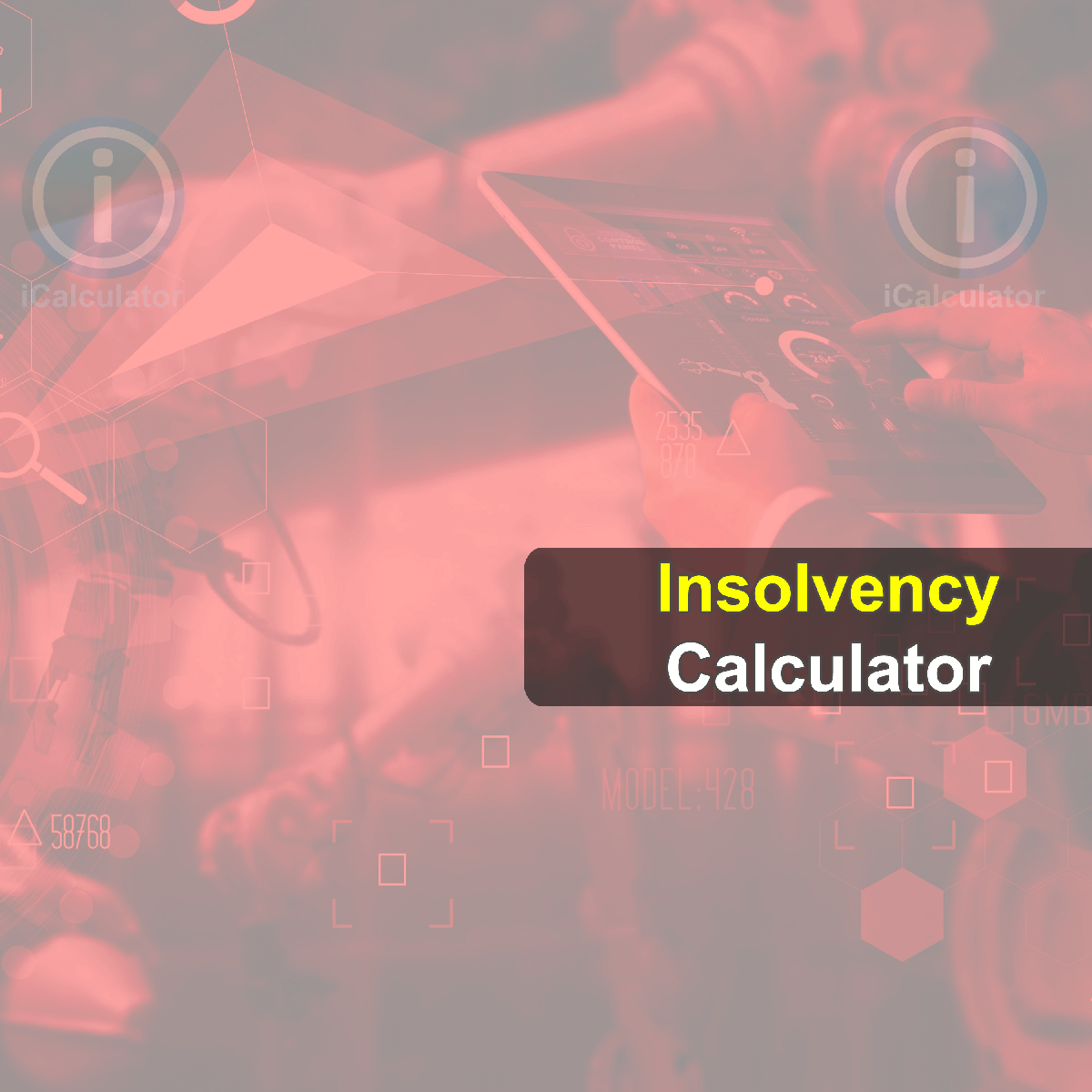Menu
Insolvency Calculator
The Insolvency Calculator allows you to compare the amount your company owes (its liabilities) against the assets the company has, the difference is those amounts provides a calculation of a company's total liabilities. On this page we also provide information about Insolvency, how insolvency is calculated with insolvency formulas and explain the difference between insolvency and bankruptcy.
| Solvency Calculations | ||
|---|---|---|
| Total Assets | ||
| - | Total Liabilities | |
| = | Net Worth | |
| = | Insolvency Status | |
Please provide a rating, it takes seconds and helps us to keep this resource free for all to use

What is Insolvency?
Insolvency (the state of being insolvent) is when a company (or individual) is no longer able to meet their financial commitments. It is important to note that a company that has a deficit between sales and expenditure is not necessary insolvent, insolvency occurs when a company has a sustained deficit either due to poor financial management, unexpected change(s) in PESTLE environment (for example the global economic impact of COVID 19 during 2019-2020), increases in transformation cost(s) or by creditors calling in debts.
It is worth noting that Insolvency due to extraordinary circumstances like that of the global economic impact of the COVID 19 Pandemic result in many businesses all suffering insolvency at the same time. This can lead to a wider economic impact, particularly if many businesses fail to sustain sufficient cash flow to maintain their overheads. As such, governmental intervention is likely as significant uplift in the numbers of insolvent and bankrupt businesses can result in high unemployment, lost productivity and trigger recession and depression.
How do I calculate if my company is insolvent?
Calculating your companies solvency is a strightforward math calculation, the challenge for most companies and individuals is typically the time it takes to gather all the information. The better companies (and also those who dont tend to become insolvent) keep regular records and accounts so know from one day to the next whether they are solvent and identifiy and rectify financial challenges as they are or ahead of their occurence by identifying trends, cause and effect.
Solvency and Insovency are calculated using the following formula:
Solvent V's Insovent Formula
i = TFA - TFLWhere:
- i: Insolvency Status: A negative figure indicates that a company is insolvent, a positive number indicates that a company is solvent.
- TFA: Total Financial Assets
- TFL: Total Financial Liabilities
We will now look at the factors that are typically grouped as assets and liabilities to ascertain how each of those totals are calculated.
What are my Company's Financial Assets
In the context of this calculator, "Assets" are the items, cash, property, stock, plat, machinery, fixtures, fittings and other items which have a financial value. Your company's financial assets can be simply defined by the following formula:
Company Financial Assets Formula
TFA = cb + ch + d + f + pm + p + s + vh + zWhere:
- TFA: Total Financial Assets
- cb: Cash in Bank
- ch: Cash on Hand
- d: Debtors
- f: Fixtures and Fittings
- pm: Plant and Machinery
- p: Property
- s: Stock
- vh: Vehicles
- z: Any Other Assets
What are my Company's Financial Liabilities?
In the context of this calculator, "Company Liabilities" are the financial liabilities that the company has in terms of payments due and outstanding debts. In very simple terms, your company liabilities are the amount your company owes. Your company's financial liabilities can be simply defined by the following formula:
Company Financial Liabilities Formula
TFL = a + b + c + l + m + o + pa + r + t + v + xWhere:
- TFL: Total Financial Liabilities
- a:Accounting Fees Due
- b:Business Rates
- c:CT Due (Corporation Tax)
- l:Loan(s)
- m:Mortgage(s)
- o:Overdraft(s)
- pa:PAYE Due (Paye As You Earn)
- r:Rent Due
- t:Trade Creditors
- v:VAT Due (Value Added Tax)
- x:Any Other Liabilities
What Happens when a company becomes Insolvent?
An insolvent company will need to discharge all its financial commitments, this may mean that the business owner has to produce a repayment plan to creditors (though this depends on contracts, company legal entity and other factors, insolvency cases are not always like for like). It is important to note that a business owner can have a business go insolvent and continue to trade with another business or set up another business at a later date. Insolvency is not the same as bankruptcy though many confuse the two as the same, they are very different.
Bankruptcy typically has financial and legal ramifications for the owners and/or board and continuing trade as a director/CEO owner is typically prohibited.
Legislation varies between countries but for simplicity, insolvency is a situation from which business recovery and operations are sustainable, bankruptcy on the other hand is legal and structured process from which business operations cannot continue. Bankrupt companies can however be bought out and, with fresh cash injection, continue to trade. This situation however requires clear comprehension of the business failure and will typically occur only if the fault lays with poor financial management, poor efficiency or another factor that can be altered to achieve a profit and return to successful business operations.
Finance Calculators
You may also find the following Finance calculators useful.
- Debtor Days Calculator
- Current Ratio Calculator
- Credit Card Calculator
- Yield To Call Calculator
- Commute Cost Calculator
- Car Lease Calculator
- Mortgage Early Repayment Calculator
- Car Depreciation Calculator
- Discounted Payback Period Calculator
- Emi Calculator
- Annuity Calculator
- Depreciation Comparison Calculator
- Loan Calculator
- Average Quarterly Balance Calculator
- Personal Loan Calculator
- Savings And Debt Comparison Calculator
- Debt Service Coverage Ratio Calculator
- Gas Mileage Comparison Calculator
- Combined Dividend And Paye Calculator 2018
- Treasury Bills